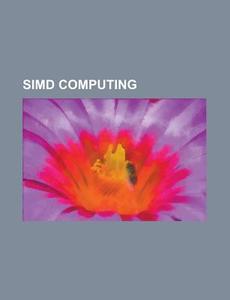
SIMD computing
- Editore:
Books LLC, Reference Series
- EAN:
9781155641119
- ISBN:
1155641116
- Pagine:
- 32
- Formato:
- Paperback
- Lingua:
- Inglese
Descrizione SIMD computing
Source: Wikipedia. Pages: 30. Chapters: 3DNow!, Advanced Vector Extensions, AltiVec, Blitzen (computer), DAP FORTRAN, Expeed, FMA instruction set, FR-V, Geometric-Arithmetic Parallel Processor, ICL Distributed Array Processor, ILLIAC III, Intel Ct, MDMX, MMX (instruction set), Multimedia Acceleration eXtensions, SIMD, SSE2, SSE3, SSE4, SSE5, SSSE3, Streaming SIMD Extensions, VEX prefix, Visual Instruction Set, Xetal, XOP instruction set. Excerpt: Single instruction, multiple data (SIMD), is a class of parallel computers in Flynn's taxonomy. It describes computers with multiple processing elements that perform the same operation on multiple data points simultaneously. Thus, such machines exploit data level parallelism. SIMD is particularly applicable to common tasks like adjusting the contrast in a digital image or adjusting the volume of digital audio. Most modern CPU designs include SIMD instructions in order to improve the performance of multimedia use. The first use of SIMD instructions was in vector supercomputers of the early 1970s such as the CDC Star-100 and the Texas Instruments ASC, which could operate on a "vector" of data with a single instruction. Vector processing was especially popularized by Cray in the 1970s and 1980s. Vector-processing architectures are now considered separate from SIMD machines, based on the fact that vector machines processed the vectors one word at a time through pipelined processors (though still based on a single instruction), whereas modern SIMD machines process all elements of the vector simultaneously. The first era of modern SIMD machines was characterized by massively parallel processing-style supercomputers such as the Thinking Machines CM-1 and CM-2. These machines had many limited-functionality processors that would work in parallel. For example, each of 64,000 processors in a Thinking Machines CM-2 would execute the same instruction at the same time, allowing, for instance multiplications on 64,000 pairs of numbers at a time. Supercomputing moved away from the SIMD approach when inexpensive scalar MIMD approaches based on commodity processors such as the Intel i860 XP became more powerful, and interest in SIMD waned. The current era of SIMD processors grew out of the desktop-computer market rather than the supercomputer market. As desktop processors became powerful enough to support real-time gaming and video processing, demand grew for this particular type of












